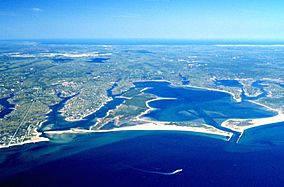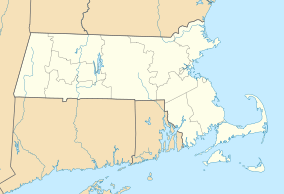Waquoit Bay National Estuarine Research Reserve facts for kids
Quick facts for kids Waquoit Bay National Estuarine Research Reserve |
|
|---|---|

An aerial view of the jetties extending out from the entrance of Waquoit Bay
|
|
| Location | Falmouth, Mashpee, Barnstable, Massachusetts, United States |
| Area | 2,700 acres (11 km2) |
| Established | 1988 |
| Operator | Massachusetts Department of Conservation and Recreation |
| Website | Waquoit Bay National Estuarine Research Reserve |
The Waquoit Bay National Estuarine Research Reserve (WBNERR) is a special natural area on the south side of Cape Cod in Massachusetts. It includes open water, sandy barrier beaches, marshy lands, and higher ground. This amazing place is looked after by the Massachusetts Department of Conservation and Recreation (DCR) and the National Oceanic and Atmospheric Administration (NOAA).
WBNERR is a great example of the northern part of the Virginian biogeographic region. It sits right where the Virginian and Acadian regions meet, making it a unique spot for different kinds of plants and animals.
Contents
Exploring the Reserve's Natural Areas
The Waquoit Bay Reserve is made up of several cool spots, each with something different to see and do.
Visitor Center and Headquarters
- The Visitor Center and Headquarters Property covers about 28 acres.
- It is open all year, Monday through Friday, from 10 AM to 4 PM.
- You can walk a short nature trail here.
- They also have many fun educational programs during different seasons.
South Cape Beach and Ponds
- This eastern part of the reserve is about 432 acres.
- It includes South Cape Beach State Park, Sage Lot Pond, and Flat Pond.
- The beach is a popular spot for swimming.
- It's also famous for fishing, especially during the yearly trips of bluefish and striped bass.
- Important birds like the piping plover and least tern build their nests here.
- Sage Lot and Flat Ponds are salt ponds located east of Waquoit Bay.
Washburn Island
- Washburn Island is another part of the reserve.
- It's a great place to explore and enjoy nature.
Quashnet River and Woodlands
- The Quashnet River Property is about 361 acres.
- This river is the biggest source of fresh water flowing into Waquoit Bay.
- It's mostly surrounded by beautiful upland forests.
- There's a three-mile (5 km) loop trail along the river for hiking.
- A group called Trout Unlimited helped turn an old cranberry bog channel back into a natural river here.
- The North Quashnet Woodlands covers 25 acres.
- It has pine forests and an old cranberry bog that is no longer used.
Waquoit Bay and Its Water Sources
- Waquoit Bay itself is a large area, about 825 acres.
- Fresh water flows into the bay from four main places: the Quashnet/Moonakis River, Red Brook, Childs River, and from underground water.
Salt Ponds for Kayaking
These salt ponds are east of Waquoit Bay and are best explored by kayak:
- Hamblin Pond, about 141 acres.
- Jehu Pond, about 172 acres.
- Abigail's Brook.
Freshwater Ponds for Fun
These freshwater ponds drain into Waquoit Bay from the north. They are great for kayaking and fishing:
- Bog Pond, about 2.8 acres.
- Bourne Pond, just over 10 acres. It's considered a "Great Pond" under Massachusetts law, meaning it belongs to everyone and is not privately owned.
- Caleb Pond, about 5.7 acres.
- Childs River: This area has old cranberry bogs and pine forests.
A Look Back: History of the Reserve
People have lived around Waquoit Bay for a very long time.
Early Inhabitants
- Tools and shell piles (called middens) from 450 to 1000 years ago have been found on Washburn Island.
- As late as the early 1800s, some Wampanoag people still lived near Bourne and Caleb ponds.
- There was a spring there that provided fresh water for both Native Americans and new settlers.
Protecting the Area
- The main buildings for the reserve's office, research, and education are in the old Sargent Estate buildings.
- The Commonwealth of Massachusetts bought these buildings in 1987 and carefully restored them.
- The Quashnet River Property was also bought in 1987 and added to the Reserve.
- The Reserve and the Division of Fisheries and Wildlife work together to manage the river property.
Things to Do at Waquoit Bay Reserve
Besides learning programs, the reserve offers many ways to enjoy the outdoors:
- Hiking on trails.
- Boating in the waters.
- Camping in designated areas.
- Fishing for various species.
- Hunting in specific, restricted areas.


